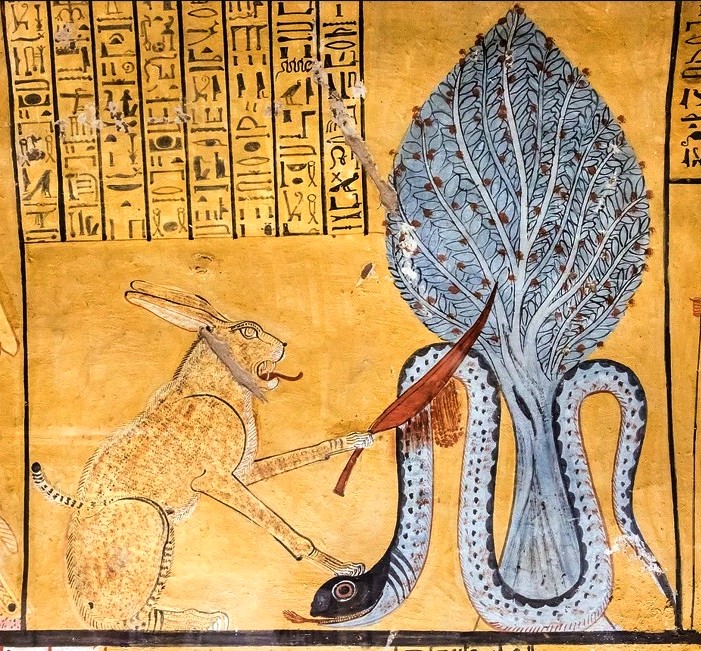Sacred Tree or Paradise Tree? The Christmas Tree and Nature

During the Middle Ages, the church used mystery plays to dramatize biblical stories for largely illiterate people to illustrate the stories of the bible "from creation to damnation to redemption". (Inventing the Christmas Tree by Bernd Brunner (2012) p 15 ) Thus, we find evidence of a connection between the Christmas tree and the Tree of Life in the Paradise plays as well as pagan sacred trees.
In western Germany, the story of Adam and Eve was acted out using a prop of a paradise tree, a fir tree decorated with apples to represent the Garden of Eden:
"The Germans set up a paradise tree in their homes on December 24, the religious feast day of Adam and Eve. They hung wafers on it (symbolizing the eucharistic host, the Christian sign of redemption); in a later tradition the wafers were replaced by cookies of various shapes. Candles, symbolic of Christ as the light of the world, were often added. In the same room was the "Christmas pyramid," a triangular construction of wood that had shelves to hold Christmas figurines and was decorated with evergreens, candles, and a star. By the 16th century the Christmas pyramid and the paradise tree had merged, becoming the Christmas tree."



A good example of this old tradition is the mystery plays of Oberufer. The Austrian linguist and literary critic Karl Julius Schröer (1825-1900) "discovered a Medieval cycle of Danube Swabian mystery plays in Oberufer, a village since engulfed by the Bratislava's borough of Főrév (German: Rosenheim, today's Ružinov). Schröer collected manuscripts, made meticulous textual comparisons, and published his findings in the book Deutsche Weihnachtspiele aus Ungarn ("The German Nativity Plays of Hungary") in 1857/1858."

But see, but see a tree stands here
Which precious fruit doth bear,
That God has made his firm decree
It shall not eaten be.
Yea, rind and flesh and stone
They shall leave well alone.
This tree is very life,
Therefore God will not have
That man shall eat thereof.

"In the Garden of Eden God planted two trees, the Tree of Knowledge of Good and Evil, and The Tree of Life. Eating from the former gave one moral knowledge; eating from the latter conferred eternal life. He also placed man in that garden to tend to the plants but told him he may not eat from the Tree of Knowledge (and therefore become morally knowledgeable). About eating from the Tree of Life, God said nothing: "But of the tree of the knowledge of good and evil, thou shalt not eat of it: for in the day that thou eatest thereof thou shalt surely die" (Gen 2:17). [...] Adam and Eve did not die when they ate from the tree. Indeed, God feared that they would next eat from The Tree of Life and gain immortality." (101 Myths of the Bible by Gary Greenberg (2000) p.48)
Greenberg notes the similarity of these ideas with Egyptian texts and traditions, specifically the writings from Egyptian Coffin Text 80 concerning Shu and Tefnut:
"The most significant portions of Egyptian Coffin Text 80 concern the children of Atum, the Heliopolitan Creator. Atum's two children are Shu and Tefnut, and in this text Shu is identified as the principle of life and Tefnut is identified as the principle of moral order, a concept that the Egyptians refer to as Ma'at. These are the two principles associated with the two special trees in the Garden of Eden, the Tree of Life and the Tree of Knowledge of Good and Evil. Not only does the Egyptian text identify these same two principles as offspring of the Creator deity, the text goes on to say that Atum (whom the biblical editors had confused with Adam) is instructed to eat of his daughter, who signifies the principle of moral order. "It is of your daughter Order that you shall eat. (Coffin Text 80, line 63). This presents us with a strange correlation. Both Egyptian myth and Genesis tell us that the chief deity created two fundamental principles, Life and Moral Order. In the Egyptian myth, Atum is told to eat of moral order but in Genesis, Adam is forbidden to eat of moral order." (101 Myths of the Bible by Gary Greenberg (2000) p.49)
In another description we can see the similarities between the Egyptian and biblical stories:
"Atum-Ra looked upon the nothingness and recognized his aloneness, and so he mated with his own shadow to give birth to two children, Shu (god of air, whom Atum-Ra spat out) and Tefnut (goddess of moisture, whom Atum-Ra vomited out). Shu gave to the early world the principles of life while Tefnut contributed the principles of order. Leaving their father on the ben-ben [the mound that arose from the primordial waters Nu upon which the creator deity Atum settled], they set out to establish the world. In time, Atum-Ra became concerned because his children were gone so long, and so he removed his eye and sent it in search of them. While his eye was gone, Atum-Ra sat alone on the hill in the midst of chaos and contemplated eternity. Shu and Tefnut returned with the eye of Atum-Ra (later associated with the Udjat eye, the Eye of Ra, or the All-Seeing Eye) and their father, grateful for their safe return, shed tears of joy. These tears, dropping onto the dark, fertile earth of the ben-ben, gave birth to men and women."
However, Greenberg points out the differences between the two stories:
"Despite the close parallels between the two descriptions there is one glaring conflict. In the Egyptian text Nun (the personification of the Great Flood) urged Atum (the Heliopolitan Creator) to eat of his daughter Tefnut, giving him access to knowledge of moral order. In Genesis, God forbade Adam to eat from the Tree of Knowledge of Good and Evil, denying him access moral knowledge." (101 Myths of the Bible by Gary Greenberg (2000) p.51)
Why was Adam denied access to moral knowledge? Greenberg writes:
"God feared that he would obtain eternal life if he ate from the Tree of Life and it became necessary to expel him from the Garden. [...] The Egyptians believed that if you lived a life of moral order, the god Osiris, who ruled over the afterlife, would award you eternal life. That was the philosophical link between these two fundamental principles of Life and Moral Order, and that is why Egyptians depicted them as the children of the Creator. In effect, knowledge of moral behaviour was a step towards immortality and godhead. That is precisely the issue framed in Genesis. When Adam ate from the Tree of Knowledge of Good and Evil, God declared that if Adam also ate from the Tree of Life he would become like God himself. But Hebrews were monotheists. The idea that humans could become god-like flew in the face of the basic theological concept of biblical religion, that there was and could be only one god. Humans can't become god-like." (101 Myths of the Bible by Gary Greenberg (2000) p51/52)

Adam and Eve and the Serpent—Expulsion from Paradise, ca. 1480-1500 (Anonymous)
Greenberg then describes the fundamental differences between Hebrew monotheism and Egyptian polytheism:
"The Hebrew story is actually a sophisticated attack on the Egyptian doctrine of moral order leading to eternal life. It begins by transforming Life and Moral Order from deities into trees, eliminating the cannibalistic imagery suggested by Atum eating of his daughter. Then, Adam was specifically forbidden to eat the fruit of Moral Order. Next, Adam was told that not only wouldn't he achieve eternal life if he ate of Moral Order but that he would actually die if he did eat it. Finally, Adam was expelled from the Garden before he could eat from the Tree of Life and live for eternity. [...] When God told Adam that he would surely die the very day he ate from the Tree of Knowledge, the threat should be understood to mean that humans should not try to become like a deity. God didn't mean that Adam would literally drop dead the day he ate the forbidden fruit; he meant that the day Adam violated the commandment he would lose access to eternal life. [...] Once he violated the commandment, he lost access to the Tree of Life and could no longer eat the fruit that prevented death." (101 Myths of the Bible by Gary Greenberg (2000) p51/52)
The difference between the lord/slave relationship of monotheism and the nature-based ideology of polytheistic paganism is that the subject is denied an eternal place with the master in the former but is welcomed as an equal in the latter. This is because the subject is an integral part of nature in paganism:
"In the shamanic world, not only every tree, but every being was and is holy - because they are all imbued with the wonderful power of life, the great mystery of universal Being. "Yes, we believe that, even below heaven, the forests have their gods also, the sylvan creatures and fauns and different kinds of goddesses" (Pliny the Elder II, 3). (Pagan Christmas: The Plants, Spirits, and Rituals at the Origins of Yuletide by Christian Ratsch and Claudia Muller- Ebeling (2003) p24)
It is also important to note "that the "serpent in the tree" motif associated with the Adam and Eve story comes directly from Egyptian art. The Egyptians believed that Re, the sun God that circled the earth every day, had a nightly fight with the serpent Aphophis and each night defeated him. Several Egyptian paintings show a scene in which Re, appearing in the form of "Mau, the Great Cat of Heliopolis," sits before a tree while the serpent Apophis coils about the tree, paralleling the image of rivalry between Adam and the serpent in the tree of the Garden of Eden." (101 Myths of the Bible by Gary Greenberg (2000) p49/50)

By the 1970s, the term Indigenous was used as a way of "linking the experiences, issues, and struggles of groups of colonized people across international borders", thus politicising their resistance to the dominant colonising narratives that historically spread while using Christianity as a form of social control on a global scale.
Thus, whether the Christmas tree arises out of the pagan worship of trees or the nature-based polytheism of Egyptian lore about Life and Knowledge (as the Paradise Tree), the Christmas tree still plays an important and special part in our lives today, demonstrating that our relationship with nature goes back millennia. We can choose to be exiled from nature or become involved in the cycles of nature in ways that end our current destructive practices.

Caoimhghin O Croidheain
Caoimhghin Ó Croidheáin is an Irish artist, lecturer and writer.
Latest from Caoimhghin O Croidheain
- Becoming the Backdrop: The Oppression of Native Americans in Hollywood cinema, and 'Killers of the Flower Moon'
- 'Prophet Song': The secular apocalypse
- Art and Struggle: Olive Trees as Symbols of Palestinian Culture, Food, and Heritage
- Captain Rock: The symbol of a risen people
- Warriors and Domestics: Plotting a New Class-Conscious Course in Cinema
